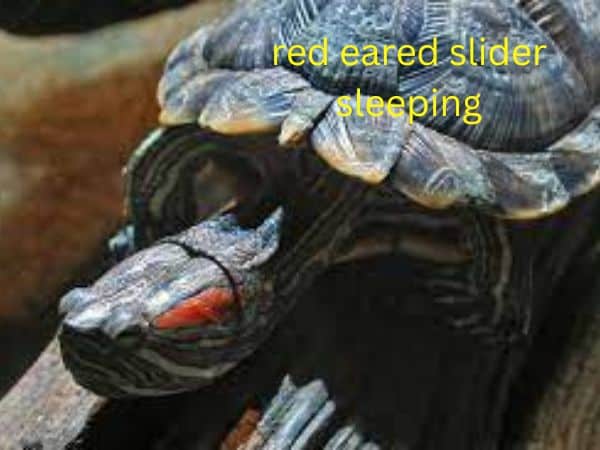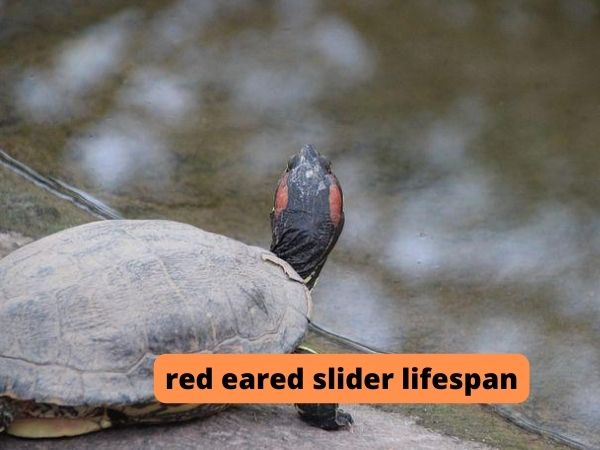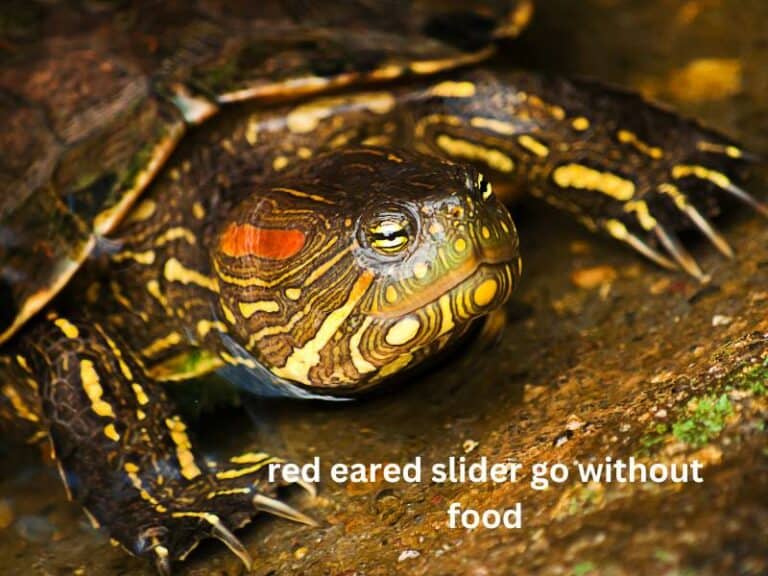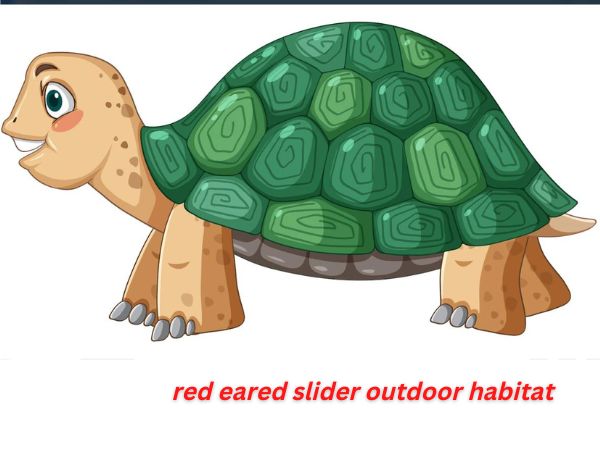Red Eared Slider Diet | turtlevoice
Today we discuss Red Eared Slider Diet. Many people love the added splash of color a Red Ear Slider can bring to an aquarium or terrarium, and many don’t realize that understanding the specific dietary needs of your pet is essential in helping them live their best lives. Too often owners become confused about what types of food will provide the nourishment needed for proper growth and development, so it’s important to have accurate information on hand.
In this blog post, we’ll explain everything you need to know about Red Ear Slider Diet; from preferred foods and supplements to the frequency of feedings and helpful tips! Read on to discover how you can best look after your beloved slider.
Overview of Red Eared Slider Diet:
Commercial Diets:
Commercial diets are formulated basically for Red Eared Slider turtles and can provide balanced nutrition. They contain all the essential nutrients that a Red Eared Slider needs, including proteins, carbohydrates, vitamins, and minerals. Some of the most popular commercial diets are pellets, crumbles, worms, shrimp, and greens.
They should be supplemented with occasional live prey such as bluegill or minnows for a diverse and nutritious diet. It is important to follow the instructions provided on the packaging when feeding your Red Eared Slider turtle.
Live Foods:
Live foods make up an important part of a red-eared slider’s diet. Live foods include earthworms, crickets, mealworms, wax worms, minnows, and various other aquatic insects. Live food helps to provide the turtle with essential nutrients and vitamins it needs for good health. Live food can also help keep the turtle active and entertained.
It is important to feed live foods in moderation as too much can lead to obesity or other health problems. all live food should be properly washed before feeding to reduce any potential risks from bacteria or parasites.
Insects:
Insects are an important part of the Red Eared Slider diet. They provide protein and other essential nutrients that help keep the slider healthy and active. Common insects offered as food for sliders include crickets, mealworms, wax worms, fruit flies, earthworms, and aquatic snails.
It is also important to supplement their diet with vegetables such as romaine lettuce and collard greens. In addition to insects, a variety of fish can be offered as occasional treats. Juvenile sliders may also benefit from sinking turtle pellets or floating sticks specifically formulated for turtles. Overall, a varied diet is key for keeping your Red-Eared Slider happy and healthy.
Fish:
Fish can be a great part of the diet for Red Eared Sliders. They are omnivores, which means that they eat both plants and animals, so fish is a nutritious source of protein for them. Fish should be fed in moderation to avoid overfeeding, as well as to provide variety in their diet.
The types of fish recommended for Red Eared Sliders include frozen or live feeder guppies, goldfish, earthworms, mealworms, crickets, and shrimp. Be sure to remove any uneaten food after 15 minutes to prevent water contamination. It’s also important to thoroughly clean the tank before adding new fish or foods into it. vitamins should be added regularly to ensure a healthy balanced diet.
Reptiles:
Reptiles such as the Red-Eared Slider need a varied diet that includes insects, fish, earthworms, leafy greens, and prepared commercial diets. It is important to feed them in moderation and provide a variety of foods for proper nutrition. Foods should be soft enough for them to chew easily and small enough for them to swallow.
They also require calcium from supplements or cuttlebone to prevent metabolic bone disease. Insects should be dusted with calcium powder before feeding. All foods should be fed in moderation; overfeeding can lead to obesity and other health issues. Fresh, clean water must always be provided for drinking and soaking.
red eared slider diet in the wild:
In the wild, red-eared sliders feed primarily on aquatic plants and animals, including insects, crustaceans, worms, mollusks, frogs, and fish. They may also consume fruits and vegetables if these items are available.
They will occasionally scavenge for carrion as well. In captivity, their diet should include a variety of dark leafy greens, commercial turtle pellets, and occasional treats such as crickets or earthworms. A calcium supplement should be added to their food every other feeding.
Importance of proper diet for red-eared slider:
Nutritional Benefits:
- The nutritional benefits of a proper diet for red-eared slider turtles include improved growth rate, better energy levels, and stronger shell development.
- A healthy diet should include proteins, carbohydrates, fats, vitamins, minerals, and fiber to provide the turtle with the nutrients needed to grow and thrive.
- Proper nutrition also helps maintain healthy eyesight, supports proper digestion, and maintains hydration.
- a well-balanced diet provides essential micronutrients that help boost immunity and reduce digestive problems.
- a good quality diet helps ensure the turtle’s long-term health by providing adequate amounts of calcium for strong bone development.
Avoiding Health Issues:
- To avoid health issues, it is important to feed your red-eared slider a balanced diet that is high in proteins, vitamins, and minerals.
- An appropriate diet should include a variety of fresh vegetables (such as kale, dandelion greens, and sweet potatoes), dark leafy greens (such as spinach and collard greens), and commercial turtle pellets or sticks.
- Avoid feeding them food such as hamburgers, hot dogs, pork chops, or any type of processed meats as these can cause digestive issues or obesity. It’s also best to limit their treats as too much can be unhealthy for them. you should ensure they always have access to clean water and make sure the tank environment is kept clean regularly.
- This will help promote healthy and happy turtles.
Recommended Feeding Amounts of a red-eared slider:
- Feeding amounts should be small and limited to once or twice a day. Offer only as much food as your turtle can eat in five minutes—any more than this will lead to obesity and other health problems.
- Avoid feeding your turtle human food like beef or chicken—these can cause serious vitamin deficiencies and imbalance the diet.
- It is also important to never give your turtle treats like bread or fried foods as these can cause digestive problems.
- it is important to never feed your turtle from the same bowl or plate as you or other family members. This can spread bacteria and increase the risk of infections and disease.
Feeding Frequency of a red-eared slider:
- Feeding frequency should be monitored based on age; adults should feed 2 to 3 times per week and young turtles need more frequent meals every day.
- Feeding an adult red-eared slider 2 or 3 times a week is usually enough. The younger turtles need more frequent meals as they are growing quickly, so feed them every day instead.
- A good rule of thumb for all age groups is to only feed them a quantity that can be consumed within 5 minutes.
- Take care not to overfeed as this could lead to health problems such as malnutrition and obesity.
tips for Red Eared Slider Diet:
- it is essential to provide clean water daily for your turtle’s hydration needs.
- Avoid giving processed foods such as potato chips or French fries because they lack the nutrition that turtles need for growth and health maintenance.
- never feed them wild-caught fish or insects from lakes or ponds; these may contain parasites that can be harmful to your turtle.
- it is important to not rely solely on this type of food as it often contains added sugars and preservatives which are unhealthy for turtles.
red-eared slider eating its own eggs!
Red-eared slider turtles may eat their own eggs for a variety of reasons. One common reason can be attributed to their natural instinct – red-eared sliders are omnivorous, meaning they eat both plants and animals. if the eggs are in a vulnerable position or simply look appetizing, the turtle may decide to snack on them.
red eared sliders may also eat their own eggs as a way to conserve energy during times of food scarcity. If there is not enough food available in the environment, then eating eggs can provide an additional source of nutrition that can help the turtle survive until more food becomes available.
it’s possible that red-eared sliders may also consume their own eggs out of boredom or frustration, as they are naturally curious creatures.
Faqs for Red Eared Slider Diet:
Yes, red-eared sliders can eat mealworms. Mealworms are a suitable food for these reptiles, as they provide both protein and fat. A varied diet of other insects, aquatic plants, and commercial turtle food is recommended to provide a balanced diet.
Yes, you can feed your Red Eared Slider fruits and vegetables. it should be done in moderation and only as a supplement to their regular diet. Vegetables like carrots, squash, and green beans are a great source of nutrients for your turtle.
Insects safe for Red Eared Sliders to eat include crickets, mealworms, waxworms, earthworms, and blackworms. It is also safe for them to eat a variety of aquatic invertebrates, such as bloodworms, shrimp, and snails.
Yes, it is safe to feed your Red Eared Slider fish. They are omnivores and can eat a variety of foods including vegetables, small insects, worms, and pellets. Make sure to provide them with a balanced diet for optimal health.
No, you should not feed your Red Eared Slider other reptiles. It is not healthy for them to eat food that is not a part of their natural diet. Feeding them other reptiles is not recommended and can even cause harm to your turtle.
The best diet for Red Eared Sliders consists of a variety of commercial foods such as pellets, crickets, worms, and freeze-dried or frozen aquatic invertebrates. Some good vegetables to offer are kale, romaine lettuce, sweet potatoes, squash, and zucchini. Fruits such as mango, papaya, blueberries, and apples can also be offered as occasional treats.
Red-eared slider hatchling diet should include a variety of protein sources, such as small fish, earthworms, crickets, and commercial turtle pellets. they need to be offered dark leafy greens like collard greens or turnip greens for added vitamins and minerals. Calcium powder sprinkled on food helps ensure proper skeletal development.
A red-eared slider’s favorite food is mainly aquatic plants and small invertebrates, such as worms, snails, insects, crayfish, and other crustaceans. They also enjoy eating commercial turtle pellets and occasional fruits and vegetables.
No, red eared sliders typically do not eat dog food. They are omnivores and prefer to feed on aquatic vegetation, insects, fish and crustaceans. Commercial turtle foods formulated specifically for their species should be provided.
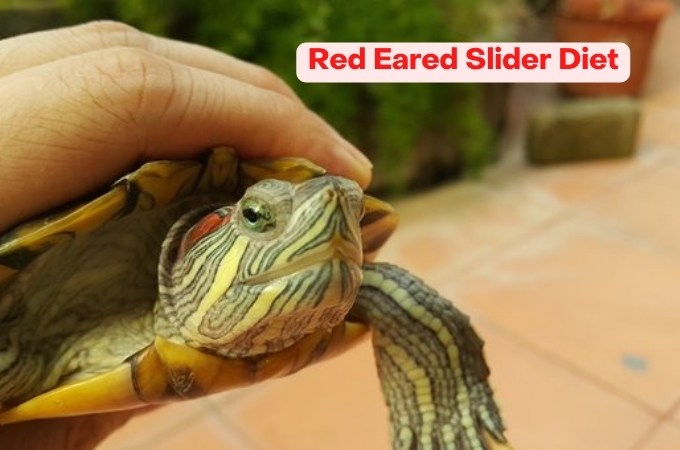
Summary of Red Eared Slider Diet:
A well-balanced diet is essential for your red eared slider to maintain optimal health and shell strength. It’s important to offer a variety of foods to ensure they get the nutrients they need and avoid overfeeding which can lead to obesity and other health problems. Incorporate both live food and pellets into their diet, and offer vegetables as a supplement several times a week. With proper care, your red-eared slider can enjoy a long and healthy life.
